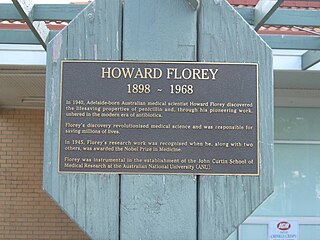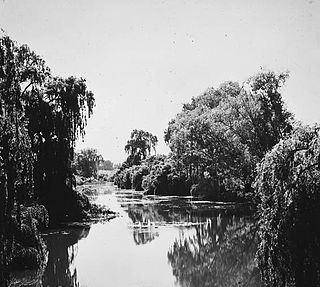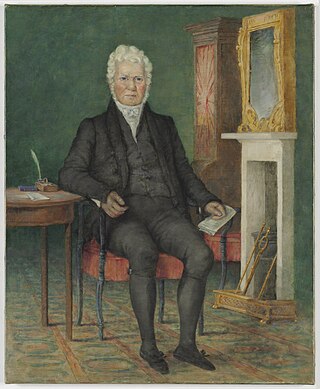
The Australian Capital Territory (ACT), known as the Federal Capital Territory (FCT) until 1938, is a federal territory of Australia. Canberra, the capital city of Australia, is situated within the territory. It is located in southeastern Australian mainland as an enclave completely within the state of New South Wales. Founded after Federation as the seat of government for the new nation, the territory hosts the headquarters of all important institutions of the Australian Government.

Canberra is the capital city of Australia. Founded following the federation of the colonies of Australia as the seat of government for the new nation, it is Australia's largest inland city and the eighth-largest Australian city overall. The city is located at the northern end of the Australian Capital Territory at the northern tip of the Australian Alps, the country's highest mountain range. As of June 2023, Canberra's estimated population was 466,566.

William James Farrer was a leading English Australian agronomist and plant breeder. Farrer is best remembered as the originator of the "Federation" strain of wheat, distributed in 1903. His work resulted in significant improvements in both the quality and crop yields of Australia's national wheat harvest, a contribution for which he earned the title 'father of the Australian wheat industry'.

Lake George is an endorheic lake in south-eastern New South Wales, Australia. It is approximately 40 kilometres (25 mi) north-east of Canberra located adjacent to the Federal Highway en route to Goulburn and Sydney. Lake George is also the name of a locality on the western and southern edges of the lake, within the area of the Queanbeyan–Palerang Regional Council.
The history of Canberra details the development of the city of Canberra from the time before European settlement to the city's planning by the Chicago architect Walter Burley Griffin in collaboration with Marion Mahony Griffin, and its subsequent development to the present day.

Campbell is a suburb of Canberra, Australian Capital Territory, Australia. Covering an area to the South East of the central business district, Campbell sits at the base of Mount Ainslie and is bounded to the south east by the Mount Pleasant Nature Reserve. At the 2021 census, Campbell had a population of 6,564 people.

Sir Murray Louis Tyrrell was an Australian public servant, noted as the Official Secretary to the Governor-General of Australia for a record term of 26 years, 1947–73, in which time he served six governors-general.

Sir Austin Chapman was an Australian politician who served in the House of Representatives from 1901 until his death in 1926. He held ministerial office in the governments of Alfred Deakin and Stanley Bruce, serving as Minister for Defence (1903–1904), Postmaster-General (1905–1907), Minister for Trade and Customs, and Minister for Health (1923–1924).

Florey is a residential suburb of the Belconnen district of Canberra, located within the Australian Capital Territory, Australia. Florey was gazetted on 5 August 1975 and most houses were constructed in the mid-1980s.
Kenny is a designated suburb in the Canberra, Australia district of Gungahlin. The suburb is named in honour of Elizabeth Kenny, an Australian who pioneered muscle rehabilitation practices which serve as the foundation of physiotherapy. It is adjacent to the suburbs of Watson, Lyneham, the Mitchell industrial estate, Harrison and Throsby and bounded by the Federal Highway to the east and Horse Park Drive to the north. The suburb Kenny is situated about 4 km from the Gungahlin Towncentre and 8 km from the centre of Canberra.

St John the Baptist Church is an Australian Anglican church in the Canberra suburb of Reid in the Australian Capital Territory. The church is located at the corner of Anzac Parade and Constitution Avenue, adjacent to the Parliamentary Triangle, and is the oldest surviving public building within Canberra's inner city and the oldest church in the Australian Capital Territory. It has been described as a "sanctuary in the city", remaining a small English village-style church even as Australia's capital grew around it. Over time, it became a focal point for Australia's governors-general, politicians, public servants and military leaders, and has hosted royalty on numerous occasions.

Mount Pleasant is a hill with an elevation of 663 metres (2,175 ft) AHD that is located in the north–eastern suburbs of Canberra in the Australian Capital Territory, Australia. The hill overlooks the Australian Defence Force Academy and the Royal Military College at Duntroon. On the top of the hill is a memorial to all ranks of the Royal Regiment of Australian Artillery. The summit can be accessed by car using General Bridges Drive and is open to the public during daylight hours.

AFL Canberra is the name of the local governing body for and premier competition of Australian rules football in the Australian Capital Territory.

Canberra railway station is located on the NSW TrainLink Regional Southern Line in the Australian Capital Territory, Australia. It is located in the Canberra suburb of Kingston.

The Molonglo Plain generally refers to the flood plain of the Molonglo River and specifically the one located in the Australian Capital Territory that was inundated during the mid-1960s in order to create Lake Burley Griffin. This plain was one of fours plains - the Ginninderra Plain, the Limestone Plain, and the Tuggeranong Plain are the others - upon which the city of Canberra is situated.

The Australian Institute of Architects, officially the Royal Australian Institute of Architects, is Australia's professional body for architects. Its members use the post-nominals FRAIA (Fellow), ARAIA and RAIA. The Institute supports 14,000 members across Australia, including 550 Australian members who are based in architectural roles across 40 countries outside Australia. SONA is the national student-membership body of the Australian Institute of Architects. EmAGN represents architectural professionals within 15 years of graduation, as part of the Australian Institute of Architects.

The Bombala railway line is a branch railway line in the south of New South Wales, Australia. The northern part of it forms part of the main line from Sydney to Canberra, but the southern part is closed. It branches off the Main South line at Joppa Junction, south of Goulburn. The line is used by NSW TrainLink Xplorer services running between Sydney Central and Canberra station.

Robert Campbell (1769–1846) was a merchant and politician in Sydney. He was a member of the first New South Wales Legislative Council. Campbell, a suburb of Canberra was named in his honour.
The Queanbeyan City Open was a professional golf tournament in Australia. It was an official event on the PGA Tour of Australasia in 1976 and 1977. The tournament was held at Queanbeyan Golf Club in Queanbeyan, New South Wales, a suburb of Canberra. It was the first major tournament at the Queanbeyan Golf Club.
The Chronicle was a free weekly community newspaper in Canberra, Australia. It was published by Australian Community Media from the Fyshwick headquarters of The Canberra Times and was funded through advertising. Its suspension of print publication was announced on 8 April 2020 by unrelated publication City News.





















